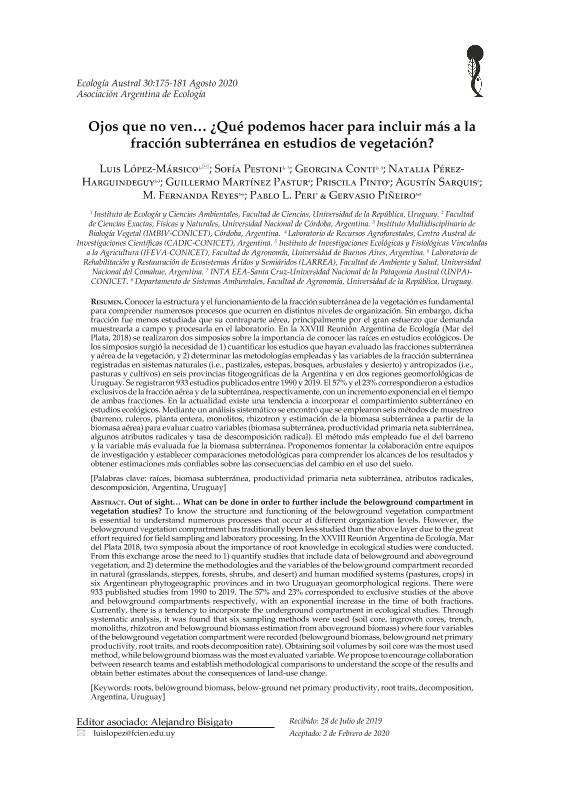Artículo
Conocer la estructura y el funcionamiento de la fracción subterránea de la vegetación es fundamental para comprender numerosos procesos que ocurren en distintos niveles de organización. Sin embargo, dicha fracción fue menos estudiada que su contraparte aérea, principalmente por el gran esfuerzo que demanda muestrearla a campo y procesarla en el laboratorio. En la XXVIII Reunión Argentina de Ecología (Mar del Plata, 2018) se realizaron dos simposios sobre la importancia de conocer las raíces en estudios ecológicos. De los simposios surgió la necesidad de 1) cuantificar los estudios que hayan evaluado las fracciones subterránea y aérea de la vegetación, y 2) determinar las metodologías empleadas y las variables de la fracción subterránea registradas en sistemas naturales (i.e., pastizales, estepas, bosques, arbustales y desierto) y antropizados (i.e., pasturas y cultivos) en seis provincias fitogeográficas de la Argentina y en dos regiones geomorfológicas de Uruguay. Se registraron 933 estudios publicados entre 1990 y 2019. El 57% y el 23% correspondieron a estudios exclusivos de la fracción aérea y de la subterránea, respectivamente, con un incremento exponencial en el tiempo de ambas fracciones. En la actualidad existe una tendencia a incorporar el compartimiento subterráneo en estudios ecológicos. Mediante un análisis sistemático se encontró que se emplearon seis métodos de muestreo (barreno, ruleros, planta entera, monolitos, rhizotron y estimación de la biomasa subterránea a partir de la biomasa aérea) para evaluar cuatro variables (biomasa subterránea, productividad primaria neta subterránea, algunos atributos radicales y tasa de descomposición radical). El método más empleado fue el del barreno y la variable más evaluada fue la biomasa subterránea. Proponemos fomentar la colaboración entre equipos de investigación y establecer comparaciones metodológicas para comprender los alcances de los resultados y obtener estimaciones más confiables sobre las consecuencias del cambio en el uso del suelo. To know the structure and functioning of the belowground vegetation compartment is essential to understand numerous processes that occur at different organization levels. However, the belowground vegetation compartment has traditionally been less studied than the above layer due to the great effort required for field sampling and laboratory processing. In the XXVIII Reunión Argentina de Ecología, Mar del Plata 2018, two symposia about the importance of root knowledge in ecological studies were conducted. From this exchange arose the need to 1) quantify studies that include data of belowground and aboveground vegetation, and 2) determine the methodologies and the variables of the belowground compartment recorded in natural (grasslands, steppes, forests, shrubs, and desert) and human modified systems (pastures, crops) in six Argentinean phytogeographic provinces and in two Uruguayan geomorphological regions. There were 933 published studies from 1990 to 2019. The 57% and 23% corresponded to exclusive studies of the above and belowground compartments respectively, with an exponential increase in the time of both fractions. Currently, there is a tendency to incorporate the underground compartment in ecological studies. Through systematic analysis, it was found that six sampling methods were used (soil core, ingrowth cores, trench, monoliths, rhizotron and belowground biomass estimation from aboveground biomass) where four variables of the belowground vegetation compartment were recorded (belowground biomass, belowground net primary productivity, root traits, and roots decomposition rate). Obtaining soil volumes by soil core was the most used method, while belowground biomass was the most evaluated variable. We propose to encourage collaboration between research teams and establish methodological comparisons to understand the scope of the results and obtain better estimates about the consequences of land-use change.
Ojos que no ven... ¿qué podemos hacer para incluir más a la fracción subterránea en estudios de vegetación?
Título:
Out of sight… What can be done in order to further include the belowground compartment in vegetation studies?
Lopez Mársico, Luis; Pestoni, Sofía ; Conti, Georgina
; Conti, Georgina ; Pérez Harguindeguy, Natalia
; Pérez Harguindeguy, Natalia ; Martínez Pastur, Guillermo José
; Martínez Pastur, Guillermo José ; Pinto, Priscila
; Pinto, Priscila ; Sarquis, Agustín; Reyes, María Fernanda
; Sarquis, Agustín; Reyes, María Fernanda ; Peri, Pablo Luis
; Peri, Pablo Luis ; Piñeiro, Gervasio
; Piñeiro, Gervasio
 ; Conti, Georgina
; Conti, Georgina ; Pérez Harguindeguy, Natalia
; Pérez Harguindeguy, Natalia ; Martínez Pastur, Guillermo José
; Martínez Pastur, Guillermo José ; Pinto, Priscila
; Pinto, Priscila ; Sarquis, Agustín; Reyes, María Fernanda
; Sarquis, Agustín; Reyes, María Fernanda ; Peri, Pablo Luis
; Peri, Pablo Luis ; Piñeiro, Gervasio
; Piñeiro, Gervasio
Fecha de publicación:
06/2020
Editorial:
Asociación Argentina de Ecología
Revista:
Ecología Austral
ISSN:
0327-5477
Idioma:
Español
Tipo de recurso:
Artículo publicado
Clasificación temática:
Resumen
Archivos asociados
Licencia
Identificadores
Colecciones
Articulos(CADIC)
Articulos de CENTRO AUSTRAL DE INVESTIGACIONES CIENTIFICAS
Articulos de CENTRO AUSTRAL DE INVESTIGACIONES CIENTIFICAS
Articulos(IFEVA)
Articulos de INST.D/INV.FISIOLOGICAS Y ECO.VINCULADAS A L/AGRIC
Articulos de INST.D/INV.FISIOLOGICAS Y ECO.VINCULADAS A L/AGRIC
Articulos(SEDE CENTRAL)
Articulos de SEDE CENTRAL
Articulos de SEDE CENTRAL
Citación
Lopez Mársico, Luis; Pestoni, Sofía; Conti, Georgina; Pérez Harguindeguy, Natalia; Martínez Pastur, Guillermo José; et al.; Ojos que no ven... ¿qué podemos hacer para incluir más a la fracción subterránea en estudios de vegetación?; Asociación Argentina de Ecología; Ecología Austral; 30; 2; 6-2020; 175-181
Compartir
Altmétricas



